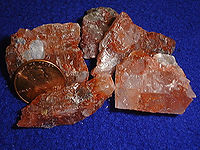
Photo from wikipedia
Abstract In wood fuels, potassium is by far the most abundant aerosol forming component. Given this predominant role, a major contribution for meeting the tightened total particulate matter emission thresholds… Click to show full abstract
Abstract In wood fuels, potassium is by far the most abundant aerosol forming component. Given this predominant role, a major contribution for meeting the tightened total particulate matter emission thresholds on European level could thus be expected by the introduction of an upper limit for potassium content in wood pellets. To evaluate options to introduce such an upper limit for the potassium content of wood pellets, an extensive pellet screening was performed in Germany covering 22 of the 46 ENplus certified wood pellet producers representing more than 50% of the current German wood pellet production of about 2 million t/year. This screening was accompanied by the compilation of wood pellet fuel data from different sources. In total, analysis data of 249 high quality wood pellet samples has been evaluated. Almost all pellet samples originated from European production whereof the majority were pellets from certified German pellet producers. The pellet screening revealed a very large variation in the potassium content of high quality wood pellets ranging from below detection limit to well above 1000 mg/kg d.b. The results also confirmed the predominant role of potassium among the aerosol forming elements potassium, sodium, lead and zinc in wood samples. Furthermore, the screening highlighted that the ash content is not sufficient to evaluate the potassium content of wood pellets. Analysis of selected raw materials from three different pellet producers revealed a strikingly large variation in the potassium content of the raw materials. Consequently, controlled adjustment of the potassium content in wood pellets in the production process would require dedicated mixtures of different raw materials and the limitation of the share of raw materials with particularly high potassium contents. In this way, the potassium content of wood pellets could be limited and this could contribute to the compliance with strict particulate emission thresholds for small scale combustion appliances. Prerequisite for such an approach would be a fast, simple and cheap possibility to determine the potassium content of raw materials for wood pellet production at the production sites and the incorporation of the potassium control in the quality assurance of the pellet production process. Consequently, wood pellets could be produced that facilitate compliance with particulate matter emission threshold without secondary emission reduction measures.
Journal Title: Fuel
Year Published: 2018
Link to full text (if available)
Share on Social Media: Sign Up to like & get
recommendations!